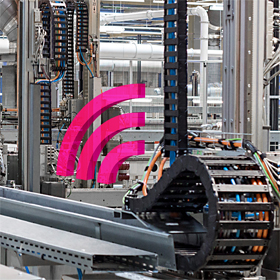Input channels for predictive maintenance with smart plastics i.Cee
Richard Habering | 26. February 2021
GIGO – Ever heard of it? Originally from computer science, this flatteringly stands for “Garbage In, Garbage Out”. In our Industry 4.0 environment, the better the plant data fed into the system, the better the predictive maintenance messages will be.

Therefore, in this article we want to deal in detail with the input channels or input options of data into the predictive maintenance system of igus – smart plastics i.Cee. To calculate service life, maintenance intervals and predictive maintenance information, the i.Cee system needs both the movement data and information about the real condition of the products. In addition to the various sensor units of the i.Sense modules, there are numerous possibilities for providing the corresponding data and movement profiles.
1 Siemens PLC connection: in the Siemens S7 series control systems from type 1200 or higher, the values for travel and/or cycles are read directly from the corresponding variables (flags). In addition, the current position of the trolley/moving end is transferred to the i.Cee system. The connection to the programming interface operates via Ethernet and does not require any further sensors.
2 Integrated acceleration sensors EC.W/EC.I: the i.Cee abrasion sensors are also equipped with acceleration sensors. By direction changes and measuring the time of motion, the system calculates a motion profile. This provides it with the necessary information to calculate the service life as well as to determine the next maintenance time.

3 OPC UA server: modern control systems often have an “OPC UA” server. In this case the values are transferred directly from the OPC UA server to the igus system. If this option is available, reading out the control system is the most precise and the most cost-effective way of communicating the movement information of the machine to the i.Cee system.
4 GPS position data: for long travels (>50m), the motion profile can also be determined via integrated or external GPS/Glonass satellite receivers.
5 igus positioning system EC.PP: the EC.PP System offers another option for determining the motion profile. This position measuring system can be used for travels with a guide trough. Beacons, which are connected by cable, are attached to the outer side parts of the guide troughs at 50cm intervals. These beacons remotely transmit their positions to a single antenna fixed to the floating moving end.
6 Standard positioning systems: in addition to the options mentioned above, classic external systems such as laser, bar code and radar systems can also be used. The communication is usually carried out via classic systems – e.g. 4-20 mA technology.
Conclusion: highly individual, but suitable for the mass market!
Predictive maintenance with smart plastics i.Cee supports a variety of input channels. This means that the motion profile can be provided precisely for each individual application, and this forms the basis for optimal maintenance information. After all, we would prefer not to know what GIGO means …

